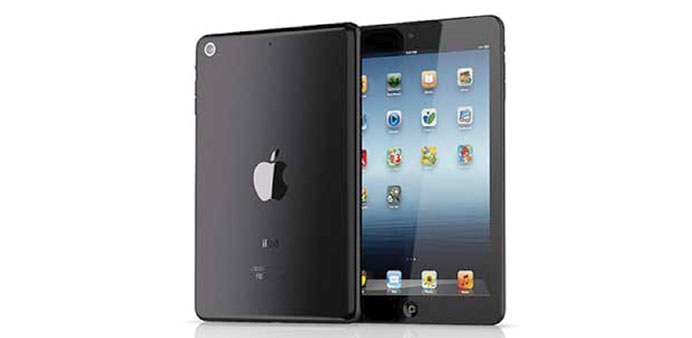By Troy Wolverton
Apple’s new iPad Air represents a refinement of the company’s tablet concept, not a revolution. But that doesn’t make it any less compelling.
You won’t find many new features on the Air, which replaces the more simply named “iPad” as Apple’s full-size flagship tablet. Nor does it work much differently from its predecessors.
What you will find, though, is a device that is much thinner, narrower and lighter than previous iPads and is thereby more enjoyable to use. It’s also, thanks to an updated processor, considerably faster, though that fact won’t be as readily apparent.
I just got the new Air on last week, so I haven’t had time yet to thoroughly test it, but it makes a favourable first impression. I considered its predecessor the best full-size tablet on the market; the Air now seems to have wrested that title away.
The distinction between the Air and previous iPads is apparent before you even take it out of its box. The Air’s box is, like the device, narrower and shorter than that for the fourth-generation iPad that preceded it.
According to Apple, the Air is 20% thinner than its predecessor and about 1.5cm narrower. Thanks to those changes, the new iPad weighs just a pound, down from 1.4 pounds previously.
The change is definitely noticeable — and appreciated. The Air’s not as light as Apple’s iPad Mini, but it feels closer to that than it does to the older iPads, which could be unwieldy to hold with one hand and could tire your arm if you held them for a long period, such as when watching a movie.
The new Air, by contrast, is much easier on the arms and, because it’s lighter, more portable. I found myself holding it while I brushed my teeth, something that was much more difficult with the older iPad.
The Air, like its predecessors, has a metal case. So, even though it’s lighter, it still feels sturdy.
The other big change is its new chip. Apple has outfitted the Air with the same 64-bit A7 chip that debuted on its iPhone 5S smartphone. The new chip offers a big boost in power.
On the standard performance tests that I ran, the new Air vastly outperformed its predecessor — and the vast majority of other smartphones and tablets.
The Air loaded “Infinity Blade 3,” a new and graphically rich game, about 10 seconds faster than did the fourth-generation iPad. It also was about 5 seconds or so faster in exporting a 20-second movie from iMovie to the device’s camera roll.
But if you’re not into high-end gaming or doing a lot of movie-making on your device, you probably won’t notice much of a difference in speed. The Air and its predecessor take about the same amount of time to launch their Mail, Web browser and Maps programmes.
To be sure, you’ll probably appreciate the speed difference more down the road than now. Future upgrades to iOS are likely to require a 64-bit processor or will run much more slowly on older processors. And over time, developers will probably write more apps that take advantage of the A7’s power.
Other changes with the Air are less apparent than its chip. It has a new Wi-Fi radio that includes two antennas rather than just one. This is supposed to give it faster speeds and make it less susceptible to interference. I didn’t test the Wi-Fi antennas thoroughly, but didn’t notice much of a difference.
If you choose to get the version of the iPad that includes a cellular radio, you’ll find that the Air is able to access more LTE networks than before on more carriers.
More notable are the things Apple didn’t include and didn’t upgrade. Unlike the iPhone 5S, the Air doesn’t have a fingerprint sensor, which Apple calls Touch ID. So if you want to prevent other people from using your tablet, you’ll have to use a passcode instead of tapping your finger to it.
Compared with the Android and Windows tablets available, the iPad has one big shortcoming: It can’t be customised for multiple users. If you plan to share your tablet with your wife or child, they’ll have access to everything you have access to — unless you turn on its customised feature restrictions every time you hand over the device.
The Air has the same basic cameras as its predecessor — a 1.2MP one in front and a 5MP one in back. It would have been nice if Apple had upgraded those, given how many people are using their tablets as cameras. But it’s not a deal-breaker that it didn’t.
Similarly, the Air has the same high-resolution Retina display as its predecessor. It’s not as high-resolution as some of its competitors, but it’s a great screen and you probably won’t be able to tell the difference.
All told, the changes Apple made to the iPad to create the Air may not sound like much. But all you have to do is pick one up to appreciate the difference. — San Jose Mercury News/MCT
iPad Air debut meets with yawns from buyers
Apple released the faster, thinnest and lightest version of its iPad last week in the US, but the usual long lines and hoopla for the launch of a new device from the consumer-tech giant were absent in the early, post-Halloween morning light.
The scene outside stores in Palo Alto, California, was muted, with only a sprinkling of customers awaiting the iPad Air release. About two dozen customers were lined up outside the store on University Avenue just a half-hour before doors opened, a little more than half the crowd that showed up for the iPad Mini launch last year, and fewer than 20 braved the chilly morning temperatures at Stanford Shopping Center.
In San Jose, no line had formed about 2 hours before the Apple store at Oakridge Mall threw open its doors, with about 15 people eventually lining up by 8am, including some couples.
“I’m the dork who showed up early,” said Kevin Anderson, who arrived at 6am at the Stanford store to claim first place in line. “I couldn’t wait.”
Anderson, an engineer for Tesla, had been iPad-less for a couple weeks after selling his second-generation device on eBay.com for a respectable $310. He has been using mostly his iPhone for Internet access.
“We only have one computer at home, and it’s always busy Pinterest-ing by my wife,” Anderson said, referencing the social media-sharing platform Pinterest. “It’s driving me nuts.”
Charles Zhou, a mobile application developer from Sunnyvale, arrived shortly before the store opened at 8am — and was still among the first customers to enter the store.
Like Anderson, Zhou said he had been without an iPad since selling his second-generation device last week on eBay for $280. He bought one of Google’s Nexus tablets to try to hold him over.
“I said, ‘Let’s see if this is enough,’ “ Zhou said. “And immediately I was like, ‘I miss iPad.’ “
Shoppers were in and out of the Stanford store in about five minutes, a few offering only a quick cheer after making their purchase — marking a stark contrast to the pomp and circumstance of Apple’s iPhone launch last month. Other customers popped in for a smartphone repair or to browse, seemingly unaware of the release event.
One customer ran up to the store about a half-hour after it opened and asked an Apple employee: “Hey, where are all the people?”
The lines may have been even shorter if Apple had allowed customers to pre-order the devices, as it did with last month’s iPhone launch and previous iPad debuts. Software engineer Erasmo Acosta drove to Stanford from Fremont, early Friday to nab an iPad Air, but said he doesn’t normally go to launch events and doesn’t particularly like them.
“But since (Apple) eliminated the presale, we’re out here in the cold,” he said. “I don’t enjoy it.”
Still, Acosta was excited to replace his year-old, fourth-generation iPad for the new iPad Air. “It’s faster, better, and the whole experience is better,” he said.
In-store sales of the iPad Air began in Australia and are headed to more than 40 other countries, marking the biggest launch yet for one of Apple’s tablets. Lines were long at some stores across the globe, with reports of many hours-long waits in some countries. The Apple store in Hong Kong sold out online before the device went on sale in stores, according to news reports. But US launches were much more subdued from New York to Palo Alto.
Apple is also preparing to release an upgraded version of the iPad Mini — the company’s answer to a device midway between a smartphone and tablet computer — sometime this month, and supply is expected to be short, such as it was with the Mini’s debut last year. The latest iteration of the 7.9-inch tablet adds the adding high-definition “retina” display available on full-sized tablets and some Mac products. — By Heather Somerville/ San Jose Mercury News/MCT



